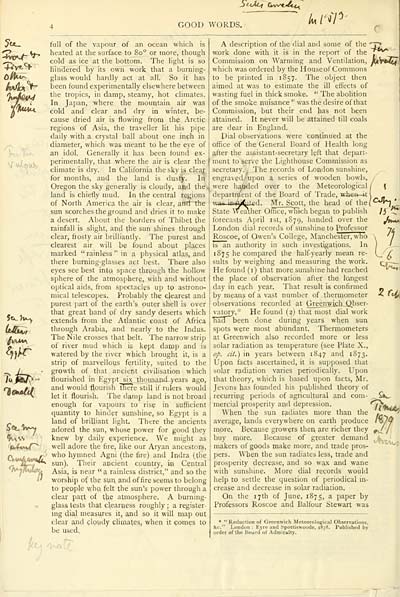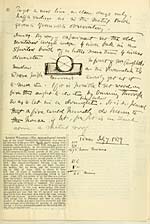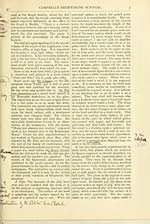Download files
Complete book:
Individual page:
Thumbnail gallery: Grid view | List view

SuAcf 0/^"*..^^
GOOD WORDS.
/m/'j7
r/0
full of the vapour of an ocean which is
heated at the surface to 80° or more, though
cold as ice at the bottom. The light is so
hindered by its own work that a burning-
glass would hardly act at all. So it has
been found experimentally elsewhere between
the tropics, in damp, steamy, hot climates.
In Japan, where the mountain air was
cold and clear and dry in winter, be-
cause dried air is flowing from the Arctic
regions of Asia, the traveller lit his pipe
daily with a crystal ball about one inch in
diameter, which was meant to be the eye of
an idol. Generally it has been found ex-
perimentally, that where the air is clear the
climate is dry. In California the sky is clear
for months, and the land is dusty. In
Oregon the sky generally is cloudy, and the.
land is chiefly mud. In the central regions
of North America the air is clear, arrd the
sun scorches the ground and dries it to make
a desert. About the borders of Thibet the
rainfall is slight, and (he sun shines through
clear, frosty air brilliantly. The purest and
clearest air will be found about places
marked " rainless " in a physical atlas, and
there burning-glasses act best. There also
eyes see best into space through the hollow
sphere of the atmosphere, with and without
optical aids, from spectacles up to astrono-
mical telescopes. Probably the clearest and
purest iiart of the earth's outer shell is over
that great band of dry sandy deserts which
extends from the Atlantic coast of Africa
through Arabia, and nearly to the Indus.
The Nile crosses that belt. The narrow strip
of river mud which is kept damp and is
watered by the river which brought it, is a
strip of marvellous fertility, suited to the
growth of that ancient civilisation which
flourished in Egypt six thousand years ago,
and would flourish there still if rulers would
let it flourish. The damp land is not broad
enough for vapours to rise in sufficient
quantity to hinder sunshine, so Egypt is a
land of brilliant light. There the ancients
adored the sun, whose power for good they
knew by daily experience. We might as
well adore the fire, like our Aryan ancestors,
who hyrnned Agni (the fire) and Indra (the
sun). Their ancient country, in Central
Asia, is near «a rainless district," and so the
worship of the sun and of fire seems to belong
to people who felt the sun's power through a
clear pa^ of tbe atmosphere, A burning-
glass tests that cl,earness roughly ; a register-
ing dial measures it, and so it will map out
clear and cloudy climates, when it comes to
be used.
A description of the dial and some of the
work done with it is in the report of the
Commission on Warming and Ventilation,
which was ordered by the House of Commons
to be printed in 1857. The object then
aimed at was to estimate the ill effects of
wasting fuel in thick smoke. " The abolition
of the smoke nuisance " was the desire of that
Commission, but their end has not been
attained. It never will be attained till coals
are dear in England.
Dial observations were continued at the
office of the General Board of Health long
after the assistant-secretary left that depart-
ment to serve the Lighthouse Commission as
secretary. The records of London sunshine,
engraved/upon a series of wooden bowls,
were haftded over to the Meteorological
departnsent of the Board of Trade, whG«-4t
wiia int/u^tfd. Mr. Sco tt, the head of the
State Weather Office, wFicli began to publish
forecasts April ist, 1879, handed over the
London dial records of sunshine to Professor
Rosc oe, of Owen's College, Manchester, who
IS an authority in such investigations. In
1875 he compared the half-yearly mean re-
sults by weighing and measuring the work.
He found (i) that more sunshine had reached
the place of observation after the longest
day in each year. That result is confirmed
by means of a vast number of thermometer
observations recorded at Gree njtjcbJ^bser-
vator y."' He found (?) that most dial work
Via3 ^been done during years when sun
spots were most abundant. Themiometers
at Greenwich also recorded more or less
solar radiation as temperature (see Plate X.,
(?/. «'/.) in years between 1847 and 1873.
Upon facts ascertained, it is supposed that
solar radiation varies periodically. Upon
that theory, which is based upon facts, Mr.
Jevons has founded his published theory of
recurring periods of agricultural and com-
mercial prosperity and depression.
When the sun radiates more than the
average, lands everywhere on earth produce
more. Because growers then are richer they
buy more. Because of greater demand
makers of goods make more, and trade pros-
pers. When the sun radiates less, trade and
prosperity decrease, and so wa.x and wane
with sunshine. More dial records would
help to settle the question of periodical in-
crease and decrease in solar radiation.
On the 17th of June, 1875, a paper by
Professors Roscoe and Balfour Stewart was
c4^
7f
• " Reduction of Greenwich Meteorological Observations,
&c." London : Eyre and :5pottiswoode, 1878. Published by
order of the Hoard of Admiralty.
GOOD WORDS.
/m/'j7
r/0
full of the vapour of an ocean which is
heated at the surface to 80° or more, though
cold as ice at the bottom. The light is so
hindered by its own work that a burning-
glass would hardly act at all. So it has
been found experimentally elsewhere between
the tropics, in damp, steamy, hot climates.
In Japan, where the mountain air was
cold and clear and dry in winter, be-
cause dried air is flowing from the Arctic
regions of Asia, the traveller lit his pipe
daily with a crystal ball about one inch in
diameter, which was meant to be the eye of
an idol. Generally it has been found ex-
perimentally, that where the air is clear the
climate is dry. In California the sky is clear
for months, and the land is dusty. In
Oregon the sky generally is cloudy, and the.
land is chiefly mud. In the central regions
of North America the air is clear, arrd the
sun scorches the ground and dries it to make
a desert. About the borders of Thibet the
rainfall is slight, and (he sun shines through
clear, frosty air brilliantly. The purest and
clearest air will be found about places
marked " rainless " in a physical atlas, and
there burning-glasses act best. There also
eyes see best into space through the hollow
sphere of the atmosphere, with and without
optical aids, from spectacles up to astrono-
mical telescopes. Probably the clearest and
purest iiart of the earth's outer shell is over
that great band of dry sandy deserts which
extends from the Atlantic coast of Africa
through Arabia, and nearly to the Indus.
The Nile crosses that belt. The narrow strip
of river mud which is kept damp and is
watered by the river which brought it, is a
strip of marvellous fertility, suited to the
growth of that ancient civilisation which
flourished in Egypt six thousand years ago,
and would flourish there still if rulers would
let it flourish. The damp land is not broad
enough for vapours to rise in sufficient
quantity to hinder sunshine, so Egypt is a
land of brilliant light. There the ancients
adored the sun, whose power for good they
knew by daily experience. We might as
well adore the fire, like our Aryan ancestors,
who hyrnned Agni (the fire) and Indra (the
sun). Their ancient country, in Central
Asia, is near «a rainless district," and so the
worship of the sun and of fire seems to belong
to people who felt the sun's power through a
clear pa^ of tbe atmosphere, A burning-
glass tests that cl,earness roughly ; a register-
ing dial measures it, and so it will map out
clear and cloudy climates, when it comes to
be used.
A description of the dial and some of the
work done with it is in the report of the
Commission on Warming and Ventilation,
which was ordered by the House of Commons
to be printed in 1857. The object then
aimed at was to estimate the ill effects of
wasting fuel in thick smoke. " The abolition
of the smoke nuisance " was the desire of that
Commission, but their end has not been
attained. It never will be attained till coals
are dear in England.
Dial observations were continued at the
office of the General Board of Health long
after the assistant-secretary left that depart-
ment to serve the Lighthouse Commission as
secretary. The records of London sunshine,
engraved/upon a series of wooden bowls,
were haftded over to the Meteorological
departnsent of the Board of Trade, whG«-4t
wiia int/u^tfd. Mr. Sco tt, the head of the
State Weather Office, wFicli began to publish
forecasts April ist, 1879, handed over the
London dial records of sunshine to Professor
Rosc oe, of Owen's College, Manchester, who
IS an authority in such investigations. In
1875 he compared the half-yearly mean re-
sults by weighing and measuring the work.
He found (i) that more sunshine had reached
the place of observation after the longest
day in each year. That result is confirmed
by means of a vast number of thermometer
observations recorded at Gree njtjcbJ^bser-
vator y."' He found (?) that most dial work
Via3 ^been done during years when sun
spots were most abundant. Themiometers
at Greenwich also recorded more or less
solar radiation as temperature (see Plate X.,
(?/. «'/.) in years between 1847 and 1873.
Upon facts ascertained, it is supposed that
solar radiation varies periodically. Upon
that theory, which is based upon facts, Mr.
Jevons has founded his published theory of
recurring periods of agricultural and com-
mercial prosperity and depression.
When the sun radiates more than the
average, lands everywhere on earth produce
more. Because growers then are richer they
buy more. Because of greater demand
makers of goods make more, and trade pros-
pers. When the sun radiates less, trade and
prosperity decrease, and so wa.x and wane
with sunshine. More dial records would
help to settle the question of periodical in-
crease and decrease in solar radiation.
On the 17th of June, 1875, a paper by
Professors Roscoe and Balfour Stewart was
c4^
7f
• " Reduction of Greenwich Meteorological Observations,
&c." London : Eyre and :5pottiswoode, 1878. Published by
order of the Hoard of Admiralty.
Set display mode to: Large image | Transcription
Images and transcriptions on this page, including medium image downloads, may be used under the Creative Commons Attribution 4.0 International Licence unless otherwise stated. ![]()
| Early Gaelic Book Collections > J. F. Campbell Collection > Campbell's registering sun-dial > (16) |
|---|
| Permanent URL | https://digital.nls.uk/78411557 |
|---|
| Description | Volumes from a collection of 610 books rich in Highland folklore, Ossianic literature and other Celtic subjects. Many of the books annotated by John Francis Campbell of Islay, who assembled the collection. |
|---|
| Description | Selected items from five 'Special and Named Printed Collections'. Includes books in Gaelic and other Celtic languages, works about the Gaels, their languages, literature, culture and history. |
|---|

